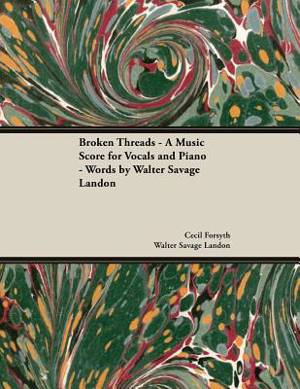
- Afhalen na 1 uur in een winkel met voorraad
- Gratis thuislevering in België vanaf € 30
- Ruim aanbod met 7 miljoen producten
- Afhalen na 1 uur in een winkel met voorraad
- Gratis thuislevering in België vanaf € 30
- Ruim aanbod met 7 miljoen producten
Zoeken
Broken Threads - A Music Score for Vocals and Piano - Words by Walter Savage Landon
Cecil Forsyth, Walter Savage Landon
Paperback | Engels
€ 13,95
+ 27 punten
Omschrijving
This volume contains the original music notation for Cecil Forsyth's "Broken Threads", a musical composition using the words of Walter Savage Landor's poem of the same name. A fantastic combination of classical music and poetry, this piece will appeal to musicians and poetry lovers alike, and it is not to be missed by collectors of Forsyth's seminal work. Walter Savage Landor (1775 - 1864) was an English writer and poet best known his works: "Imaginary Conversations" and "Rose Aylmer". Cecil Forsyth (1870 - 1941) was an English composer and musicologist. He played the viola in various orchestras in London after attending the University of Edinburgh and the Royal College of Music, where he studied together with Hubert Parry and Charles Villiers Stanford. He is best remembered for his operas "Westward Ho!" and "Cinderella", as well as the choral ballad "Tinker, Tailor". With wide margins and clear notation, this volume is highly recommended for students and musicians interested in playing Forsyth's seminal work. Many vintage books such as this are becoming increasingly scarce and expensive. We are republishing this volume now in a modern, high-quality edition complete with a specially commissioned new introduction on the history of musical notation.
Specificaties
Betrokkenen
- Auteur(s):
- Uitgeverij:
Inhoud
- Aantal bladzijden:
- 18
- Taal:
- Engels
Eigenschappen
- Productcode (EAN):
- 9781528706551
- Verschijningsdatum:
- 21/12/2018
- Uitvoering:
- Paperback
- Formaat:
- Trade paperback (VS)
- Afmetingen:
- 216 mm x 279 mm
- Gewicht:
- 72 g

Alleen bij Standaard Boekhandel
+ 27 punten op je klantenkaart van Standaard Boekhandel
Beoordelingen
We publiceren alleen reviews die voldoen aan de voorwaarden voor reviews. Bekijk onze voorwaarden voor reviews.











